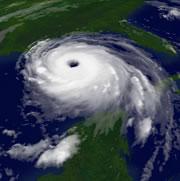 The warmer the seas, the more energy available for a storm.© NOAA
The warmer the seas, the more energy available for a storm.© NOAAWarmer ocean waters are indeed a key factor in creating more devastating hurricanes, atmospheric scientists have found. The finding confirms what many have suspected: that rising temperatures are directly linked to the upswing in hurricane intensity seen in the past few decades.
Researchers at the Georgia Institute of Technology in Atlanta examined data for a range of climate variables thought to contribute to the formation of hurricanes in categories 4 and 5, the upper end of the strength scale. Only sea surface temperature showed a strong correlation with the observed increase in the occurrence of these storms since 1970.
And with sea temperatures set to rise still further, that means the next few decades could bring even more hurricanes like Katrina, which hammered New Orleans in August 2005. "The inference is that if you keep warming things up, you're going to get more intense storms," says Judith Curry, a member of the research team.
Wind over troubled waters
Climate scientists already know that, throughout the world, hurricanes have grown in intensity although not necessarily in frequency over the past few decades (see 'Storms get fewer but fiercer'). So Curry and her colleagues examined existing data on a range of climate variables, correlating changes in these factors with trends in the occurrence of higher-category hurricanes.
Globally, only sea surface temperature increased in line with super-strong hurricanes, Curry's team reports in Science1.
The fact that warmer seas make for harsher storms may not come as a surprise. Hurricanes are formed when water evaporating from the oceans feeds a swirling mass of clouds: the warmer the water, the more energy available for the storm.
But some climate experts had suggested that other factors, such as 'wind shear', might also have contributed to the trend. A high amount of shear, in which wind speeds change swiftly with altitude, can make a storm spin more rapidly. It is reasonable to assume that high shear might go hand in hand with big storms, but the team did not find that wind shear has increased over the decades along with hurricane intensity.
Others have argued that warming influences must be small when compared with natural swings in hurricane behaviour.
Storm season
ADVERTISEMENT
Further rises in sea temperature could mean more devastating storms batter the world's hurricane-prone coastlines — with severe implications for those with a stake in the future of these regions.
"We're looking at a much worse risk than people were thinking about a year ago," says Curry. And with sea levels and rainfall set to increase as a result of global climate changes, the risk of flooding from such storms will grow, she adds.
"Some people will not return to New Orleans. They'll vote with their feet," Curry says. "And some places are going to become uninsurable."
Visit our seascausestrongerhu.html">newsblog to read and post comments about this story.
Georgia Institute of Technology
